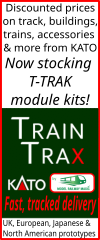- Welcome to N Gauge Forum.
New to N Scale and Have a few General Questions Based on My ResearchStarted by Drewthegreat87, April 12, 2016, 07:54:53 PM Previous topic - Next topic0 Members and 1 Guest are viewing this topic.
User actions
| Please Support Us!
December Goal:
£120.00 Due Date: Dec 31 Total Receipts: £54.56 Below Goal: £65.44 Site Currency: GBP 45% December Donations |





